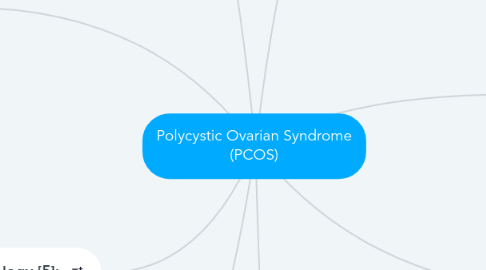
1. Pathophysiology [1]
1.1. Polycystic ovarian syndrome (PCOS) is a hormonal syndrome in females of reproductive age. It must be characterised by two or more of the following :
1.1.1. hyperandrogenism
1.1.2. polycystic ovaries morphology
1.1.3. Oligo/anovulation
2. Predisposing factors [4]:
2.1. Family history
2.2. History of weight gain (obesity)
2.3. Epilepsy, independent of epileptic drugs
2.4. Epileptic drugs
2.5. Diabetes type 1 and 2
3. Epidemiology [5]:
3.1. World wide
3.1.1. PCOS accounts for 5%-15% of females depending on criteria used.
3.2. Australia
3.2.1. PCOS effects 8-13% of reproductive aged females.
3.2.1.1. with around 21% of indigenous women diagnosed
3.2.2. Indigenous women account around 21% with those diagnosed
4. Diagnostic tests [1,6]
4.1. • Transvaginal ultrasound
4.1.1. Diagnostic tool to check the ovaries of any follicles
4.2. • Hormonal blood tests
4.2.1. Looking for as estradiol, follicle stimulating Hormone and luteinizing Hormone levels
5. References: 1. Rasquin Leon LI, Anastasopoulou C, Mayrin JV. (2021 Jul 21). Polycystic Ovarian Disease. In: StatPearls [Internet]. Treasure Island (FL): StatPearls 2. MEDS2148_Lecture 8 - Women's Health 2021, RMIT university. 3. Shetty D, Chandrasekaran B, Singh AW, Oliverraj J. (2017 Sep 1). Exercise in polycystic ovarian syndrome: An evidence-based review. Saudi Journal of Sports Medicine.;17(3):123. 4. Sirmans, S. M., & Pate, K. A. (2013). Epidemiology, diagnosis, and management of polycystic ovary syndrome. Clinical epidemiology, 6, 1–13. 5. Swannell, C. (2018). Australian-led PCOS guideline an international first. 6. Jean hill, (2018). Evidence-based guideline for the assessment and management of polycystic ovary syndrome (PCOS)
6. physical Exam Findings [2]
6.1. Hirsutism,
6.1.1. male pattern hair growth
6.2. Acne
6.2.1. facial and back acne
6.3. Infertility
6.3.1. or subfertility
6.4. Alopecia
6.4.1. Male pattern bolding
6.5. Metabolic disease
6.5.1. obesity, dyslipidaemia, diabetes
7. Treatment [1,3]
7.1. Lifestyle changes
7.1.1. Exercise : recommended duration 150mins per week
7.1.2. Dietary: avoiding carbohydrate based foods
7.2. Hormonal Medications
7.2.1. hormonal contraceptives
7.3. Metabolic medications
7.3.1. Metformin, when lifestyle changes fail
7.4. Infertility treatments
7.4.1. clomiphene citrate. to improve fertility

